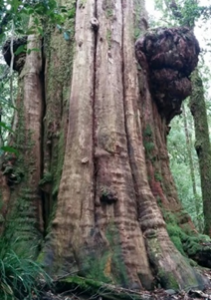Australia – a world leader
deforestation, forest degradation and extinction
Stop our wildlife being logged to death


Prevent destruction of the critical native forest carbon sink
Unlogged, Australian native forests can store more carbon per hectare than equatorial rainforests and develop the hollows needed by wildlife. Without mature forests we will lose our animals – forever
Logging Native Forests: What’s Wrong With It?
Industrial logging stops forests capturing the maximum possible amount of carbon from the atmosphere. Unlogged, forests can store carbon for centuries in maturing tree trunks, roots and branches, and for millenia in undisturbed soils. Logging not only minimises how forest trees capture and store carbon. Heavy logging machinery churns up forest floors immediately releasing carbon that has been captured and stored in the vast subterranean networks of roots and soils, for, in some cases, millenia.
Logging destroys habitat essential for the existence of wildlife. Animals not killed outright in mechanized industrialised logging opereations often die later. Multiple forest animals starve or perish in any logging operation.
Tree hollows, branches, niches in canopy, understorey or along the forest floor: all that is critical for breeding, roosting or to escape predators, is disturbed, broken, crushed or removed – by logging. The intricate interdependent web of activity between insect, leaf, flower, nectar, fruit, pollen and animal is disrupted. Cycles of growth are halted, degrading overall forest health, for one type of organism depends on another.
To maximise the chance for adaptation to any change, in particular extremes of climate, native forests now need to remain as intact as possible or allowed to recover if already logged. For survival as many diverse forms of life as possible must co-exist. The forest ecosystem comprises insect, reptile, amphibian, mammal, specialised bird species (such as owls). All are required to keep the system going. Forests need both structural and biological resilience if there is to a chance they survive heat, drought, torrential rain and fire. Industrialised logging ravages the sheltering canopy, removes the bulk of mature and immature trees, crushes understorey and groundcover rendering long term survival of forests impossible, as a strong and diverse forest is converted into a thin, fragmented, simplified stand of limited species. Modern industrial logging has set native forests on a swift extinction trajectory. This has to stop.

Logging disrupts the water cycle and disturbs and erodes forest streambanks and soils
Rainfall that was precipitated with the release of micro-organisms to the atmosphere via tall tree canopies is no longer reliable when that forest structure is destroyed. The removal of vast quantities of forest biomass disrupts the regular cycling of water vapour into moisture and its distribution through leaf to branches, trunk and roots to ground. This disruption inhibits transportation of moisture through soils, groundwater, drainage lines and streams.
Exposed to sun and wind, and without the cooling tree canopy, forests become flammable. Loggers will often burn logging debris and surviving animals often have few places to escape the flames. Many are burnt to death.
Industrial logging of native forests is not sustainable
What is driving ongoing native forest logging?
Regional Forest Agreements: legislation that exempts native forest logging from federal environment law allowing its continuance in some states for up to, and even beyond, the middle of this century.
Burning forest biomass for electricity: which saw immature native Australian forests re-defined as ‘pulp’ or ‘residue’ and burnt as ‘renewable’ electricity ‘because trees regrow’. For a while Australia legitimised the international psuedo-energy cult promoting combustion and wastage of the world’s native forest carbon sinks in power stations – all in the name of renewable energy (because companies benefited from renewable energy subsidies). In December 2022, after the launch of AFCA’s National Position Statement Against Forest Bioenergy and after a decade of diligent opposition to the false science that burning wood is carbon neutral Australia made a sensible decision. In one aspect at least of environmental protection Australia is again a leader. The Australian Forest and Climate Protection Alliance secured Federal intervention to ban burning native forest biomass for electricity as a so-called renewable. The world must follow suite as emissions have global impact. The Australian Forests and Climate Alliance will continue to advocate against highly emissive forest bioenergy and the diversion of precious carbon sinks and stores for such purpose.
Forests as fuel: a rapidly expanding threat to forest protection as corporations seek ongoing native forests:
as a cheap fuel for thermal industrial processes (heating)
as raw product for the manufacture of crude oils to refine into ‘psuedo’ renewable fuels has not yet been refused
as a form of carbon to stabilise what is known as ‘green hydrogen’
It is illogical, irresponsible and/or corrupt to destroy earth’s native forests – vital for drawing down dangerously high concentrations of atmospheric carbon – for industrial processes which pretend to be ‘green’ while often having worse climate impact than the combustion of fossil fuels.
Governments are obstinately silent on these matters. There is no national forest policy protecting our native forests from destruction for these uses. See Threats and Impacts where we demolish government and industry claims that native forest logging is sustainable and that burning native forest biomass in any form is carbon neutral.
AFCA Policy: End Native Forest Logging and Clearing to Combat Climate Change and Extinction
* slideshow photo credits:
Image 2. “Water Catchments/Carbon Sinks” – Jimmy Malecki
Image 2. “Destroyed” – North East Highlands Tasmania, Rob Blakers
Image 3. “Soils and undergrowth” – Arve Forest Old Growth Tree Roots, Tasmania Dan Broun
Image 3. “Damaged” – Serpentine Creek rainforest site of significance, Victoria, Fauna and Flora Research Collective
Image 4. “Habitat” – Sequence: Powerful Owl Fledgling, NSW, Michael Bianchino
Image 4. “Reduced to Sticks”, Tamban Forests, NSW, Nativesrule


